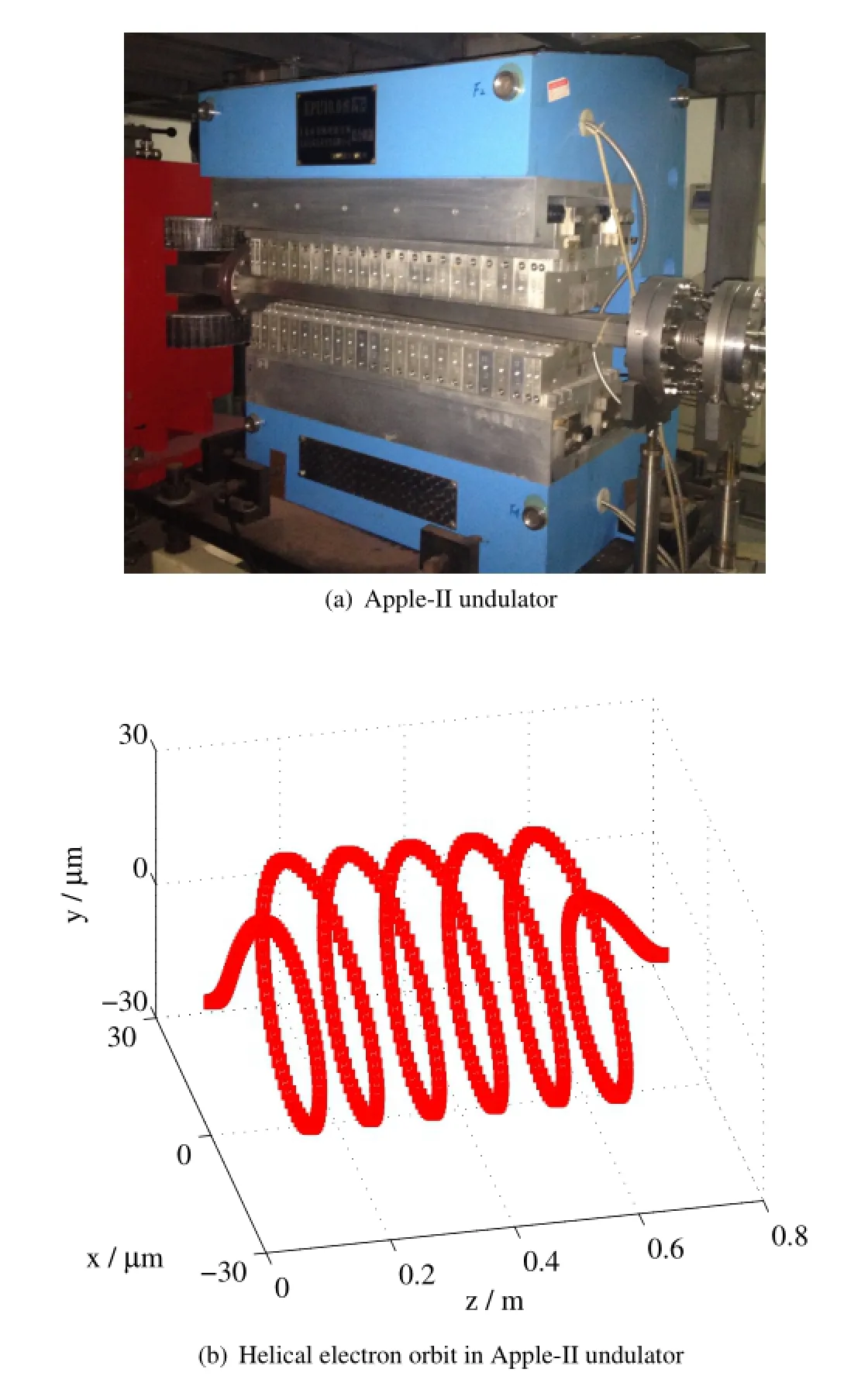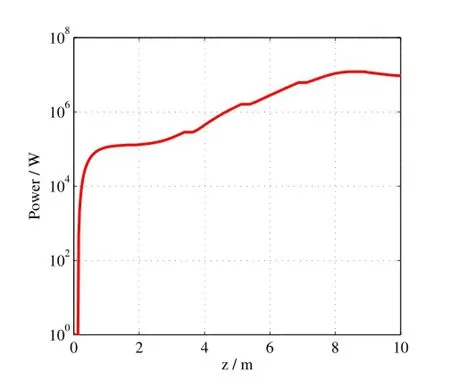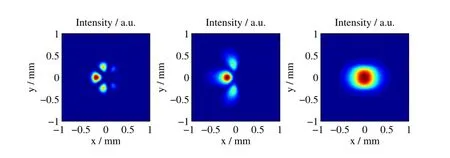Feasibility study on optical vortex generation at Shanghai deep ultraviolet free-electron laser∗
DENG Hai-Xiao(邓海啸)
1Shanghai Institute of Applied Physics,Chinese Academy of Sciences,Shanghai 201800,China
Feasibility study on optical vortex generation at Shanghai deep ultraviolet free-electron laser∗
DENG Hai-Xiao(邓海啸)1,†
1Shanghai Institute of Applied Physics,Chinese Academy of Sciences,Shanghai 201800,China
Coherent light with orbital angular momentum(OAM)is of great interest.Recently,OAM light generation by coupling a relativistic electron beam with a Gaussian mode laser pulse at the high harmonics of a helical undulator has been demonstrated experimentally.In this paper,the possibility of delivering coherent OAM light at the 3rdharmonic of the Gaussian mode seed laser is discussed for the Shanghai deep ultraviolet freeelectron laser(SDUV-FEL).Considerations are given on the experiment setup,the expected performance and the possible measurement method.
Free-electron laser(FEL),Orbital angular momentum(OAM),Shanghai deep ultraviolet(SDUV),Crosscorrelation
I.INTRODUCTION
As is well known,light carries both linear and angular momentum.One particular application of the linear momentum of light is optical tweezers[1],in which a highly focused laser beam is utilized to provide an attractive or repulsive force,typically pico-Newtons,depending on the refractive index mismatch to physically hold and move microscopic dielectric particles.Meanwhile,the orbital angular momentum(OAM)of light can also be transferred to particles,causing them to spin, and thus provide the conceptual leap in both understanding and application.In fact,after the breakthrough production of laser beams carrying def i ned amounts of OAM in the laboratory[2],many branches of optical physics,including nonlinear and quantum optics,information encoding and,of course, optical manipulation has been signif i cantly impacted[3].Undoubtedly,continuing advances in optical and other technologies will continue to drive forwards the science of OAM light and its applications.
In the last two decades,particle accelerator-based light sources,e.g.,free-electron lasers(FELs)have been developed worldwide to satisfy the dramatically growing demands of high brightness and short-wavelength radiation,especially x-ray pulses which enable simultaneous probing of both the ultra-small and the ultra-fast worlds.The successful user operations of FEL facilities[4–8]in x-ray regimes have announced the birth of x-ray laser.Considering its f l exible and reliable properties,OAM of light becomes a new topic for the FEL community[9–11],besides ultra-short pulse[12–15], full coherence[16–21]and fast polarization switch[22–25]. More recently,using electron beam as a mode-convertor on the test accelerator for SLAC’s next linear collider,a Gaussian laser has been experimentally converted to an OAM mode in an800nmFEL[26].ThispavesthewayforthecoherentOAM x-ray pulse with unprecedented brightness.
The Shanghai deep ultraviolet FEL(SDUV-FEL)is a mis-cellaneousacceleratortestfacilityforx-rayFELprinciplesand technologies[27],such as echo-enabled harmonic generation lasing[28],two-stage cascaded high-gain harmonic generation[29]and crossed-planar undulators[30],etc.It is found that SDUV-FEL is well suited for the lasing experiment of coherent OAM light with some minor modif i cations.In this paper,the possibility of delivering coherent OAM light at the 3rdharmonic of the 1047nm Gaussian mode seed laser is explored for the SDUV-FEL,a plan for the experiment is described and the expected performance is outlined.
II.SETUP FOR OAM GENERATION AND EXPECTED PERFORMANCE AT SDUV-FEL
In contrast to a normal seeded FEL scheme,the OAM light generation relies on a harmonic interaction between the electron beam and a Gaussian seed pulse in a circularly polarized undulator to naturally produce a helical energy modulation in the electron distribution,as shown in Fig.1.After passing through the dispersive chicane,the energy modulation is then converted into the helical micro-bunching,and thus the screwdistribution electrons emit and amplify coherent OAM light in a downstream planar undulator.
The helical modulator here is supposed to be a f i ve-period Apple-IItypeundulator,whichisnowservedasthehighpower terahertz emitter with the femtosecond electron bunch[31],as shown in Fig.2(a).The magnetic structure consists of four standard Halbach magnet rows above and below the electron orbitplane,anditcanbeoperatedinlinear,ellipticalorcircular polarized modes.The upper-front and lower-back magnet arrays can be moved independently along the longitudinal direction within a range of 60mm.The resonant wavelength of the Apple-II modulator can be calculated by the undulator equationλ1=λu(1+K2)/2γ2for circular polarization,whereγis the electron energy normalized to the rest energymc2,λuis the undulator period,andK=eB0λu/2πmc2is the undulator parameter,withB0being the peak magnetic f i eld of the undulator.AtB0=0.15T andλu=0.1m,Fig.2(b)illustrates the orbit of a 135MeV electron,with the resonant wavelength of the helical modulator being 2094nm in this case.

Fig.1.(Color online)Schematic setup for OAM light generation at SDUV-FEL.

Fig.2.(Color online)The Apple-II undulator and the helical orbit of 135MeV electron beam.
In such experimental conf i gurations of the seeded FEL,an initial uniform electron beam interacts with the 1047nm Gaussian mode laser pulse in the helical modulator.As a consequence of three-dimensional harmonic interaction,the f i eld prof i leE(r)/E0=exp(−r2/w2)of the linearly polarized seedlaserexcitesahelicalmodulationviathesecondharmonic resonance.The coupling is proportional to the radial variation of the Gaussian laser f i eld,thus the electrons on-axis are un-modulated,while those at the helical position ks−hϕ=nπ and the radial positionr=receive the largest energy kick,given by

where,Nis the modulator periods number,sis the electron longitudinal position,eis the charge of an electron,kis the wave number of the seed laser,andhandϕare the azimuthal mode and angle,respectively.The following dispersive magnetic chicane,characterized by the matrix transport elementR56,converts the energy modulation into a helical bunching. At the chicane exit,the bunching factor corresponding to thenthharmonic of the seed laser and thehthazimuthal mode,is then expressed as

In order to ensure that the OAM light dominates in the subsequent radiator,the correlated helical structure must exceed the intrinsic shot noise of the electron beam.Thus,a threedimensional universal algorithm[32]is used for numerically optimizing the laser-beam interactions in the helical modulator.In the simulation,both the seed laser(1047nm,2MW) andtheelectronbeam(2µmrademittance,100Apeakcurrent, 5keV sliced energy spread)are focused to 250µm.
Figure 3(a)shows the bunching factor dependences on the chicane dispersionR56,when a f i eld strength ofE0=56MV/m at the laser waist in the modulator yields an energy modulation amplitude of 25keV.For the 3rdharmonic of the seed laser,h=−3 OAM light shows the maximum bunching factor of about 12%while other azimuthal modes are well controlled.In the case of the optimal dispersionR56= 1.2mm,Fig.3(b)illustrates the beam distribution after density modulation,and a left-handed helical density modulation is clearly observed.We note that there exists a strong bunching factor at lower harmonics of the seed laser,e.g.,n=1,h=−1 andn=2,h=−2,but this is not under consideration here,because the radiator is chosen to be resonant at the 3rdharmonic.
With the optimized parameter above,the helically microbunchedbeamisimportedtoGENESIS[33]fortheOAMlight lasing calculation and the main radiator is tuned to the 3rdharmonic of the seed laser,i.e.,349nm.The main radiator consists of six segments of 1.5m planar undulator with undulator period of 25mm and undulator parameter of 1.42.The 12% coherent bunching factor of theh=−3 OAM mode is signif icantly larger than the intrinsic shot noise in modern FELs,andit is expected that theh=−3 OAM mode will be dominant at the entrance of the radiator,and will be amplif i ed further.The simulated 349nm radiation evolution is given in Fig.4,where the radiation peak power exceeds 10MW and saturates after 5 segments of the radiator.

Fig.3.(Color online)The bunching factor and the optimized beam distribution after the dispersive chicane.

Fig.4.(Color online)The 349nm radiation power growth in the main radiator undulator.
Now we consider the azimuthal mode of the 349nm radiation in the radiator.Fig.5(a)illustrates the distribution of radiation intensity and phase after the f i rst ten periods of radiator.It is clear from the radiation phase that the large bunching factor ofh=−3 is responsible for the initial production of the coherent OAM light withh=−3.The imperfect roundness in the simulated intensity patterns indicates that other optical modes also exist in the 349nm radiation,which is mainly due to the asymmetries of the electron beam,and the impurity OAM mode excitation in the helical modulator[26].
Figures 5(b)and 5(c)plot the azimuthal performances of the 349nm radiation after the f i rst segment of the radiator and after saturation,respectively.With a greater length of the radiator undulator,theh=−3 OAM mode will be surpassed by theh=0 Gaussian mode,which is due to the shorter gain length of the Gaussian mode than that of the OAM mode. This arises an important issue for the OAM mode lasing of an FEL source,besides the initial helical density modulation,i.e., the gain length of the interested OAM mode should be short enough to ensure that it dominates in the radiator undulator with respect to other optical modes.
III.OAM LIGHT MEASUREMENT METHOD
In Ref.[26],the OAM radiation was conf i rmed experimentally from the diffraction pattern when passing through a slit and an iterative phase reconstruction procedure from the known transverse prof i les of radiation,which may be utilized in the experiment of SDUV-FEL.
Here,we propose and investigate an alternative way to the cross-correlation method widely used for characterizing FEL properties[34]—it shall be more straightforward to observe cross-correlations of the OAM radiation f i eld in the transverse plane.The cross-correlation intensity are def i ned as

Therefore,one of the arms should be the mirror image of the FEL radiation in cross-correlation.Using the simulated radiation mentioned above,we have Fig.6 to illustrate a set of cross-correlation intensities for three positions of the radiator, i.e.z=0.25m,1.5m and 6m,respectively.One sees obvious difference in the transverse pattern between the Gaussian mode and OAM light.In addition,the six petals in a 2πangular period conf i rms the fact of an OAM FEL radiation with an absolute topological charge ofh=3.

Fig.5.(Color online)The azimuthal distribution of 349nm radiation in the radiator undulator.(a)at the position ofz=0.25 m,(b)at the position ofz=1.5 m and(c)at the position ofz=6.0 m.

Fig.6.(Color online)The expected cross-correlation of 349nm OAM radiation at the SDUV-FEL undulator position of 0.25m,1.5m and 6.0m,respectively.
IV.SUMMARY
In summary,coherent OAM light generation from a relativistic electron beam has been recently demonstrated in the accelerator lab,by transforming the electron beam distribution to a helix by a Gaussian mode laser.In this paper,together with a 3rdharmonic up-conversion,one possible situation of an OAM lasing experiment on SDUV-FEL is presented.The preliminary considerations on the experiment setup and expected performance are discussed.Moreover,we propose a cross-correlation method for OAM light characterization.It is shown that theh=−3 OAM light at the 3rdharmonic of the 1047nm Gaussian laser can be effectively generated.It is worth stressing that the calculation here is not fully optimized and there is still room for improvement,e.g.,the helical modulation and the electron beam size in the radiator can be further matched,and the linac beam dynamics can be optimized for the interested OAM light,rather than a Gaussianmode.We expect that OAM light approach can be extended to the short-wavelength FELs,with the most recent seeding schemes[11,20,21]and helical undulator driven harmonic lasing scheme of an FEL oscillator[35].
ACKNOWLEDGMENTS
The author would like to thank YAN Jun from Duke University for enthusiastic discussions on the helical modulation calculations,FENG Chao,ZHANG Tong,LIU Bo,SHEN Lei, WANG Xing-Tao and Prof.WANG Dong for FEL physics.
[1]Ashkin A,and Dziedzic J,Bjorkholm J E,et al.Opt Lett,1986,11,288–290.
[2]Allen L,Beijersbergen M W,Spreeuw R J C,et al.Phys Rev A,1992,45,8185–8189.
[3]Padgett M and Bowman R.Nat Photonics,2011,5,343–348.
[4]McNeil B W J and Thompson N R.Nat Photonics,2010,4, 814–821.
[5]Ackermann W,Asova G,Ayvazyan V,et al.Nat Photonics, 2007,1,336–342.
[6]Emma P,Akre R,Arthur J,et al.Nat Photonics,2010,4,641–647.
[7]Allaria E,Appio R,Badano L,et al.Nat Photonics,2012,6, 699–704.
[8]Ishikawa T,Aoyagi H,Asaka T,et al.Nat Photonics,2012,6, 540–544.
[9]Hemsing E,Musumeci P,Reiche S,et al.Phys Rev Lett,2009,102,174801.
[10]Hemsing E,Marinelli A,and Rosenzweig J B.Phys Rev Lett, 2011,106,164803.
[11]Hemsing E and Marinelli A.Phys Rev Lett,2012,109,224801.
[12]Emma P,Bane K,Cornacchia M,et al.Phys Rev Lett,2004,92, 074801.
[13]Xiang D,Huang Z,Stupakov G.Phys Rev Spec Top-AC,2009,12,030702.
[14]Yan J,Deng H X,Wang D,et al.Nucl Instrum Meth A,2010,621,97–104.
[15]Feng C,Chen J H,Zhao Z T.Phys Rev Spec Top-AC,2012,15, 080703.
[16]Amann J,Berg W,Blank V,et al.Nat Photonics,2012,6,693–698.
[17]Xiang D,Ding Y,Huang Z,et al.Phys Rev Spec Top-AC,2013,16,010703.
[18]McNeil B W J,Thompson N R,Dunning D J.Phys Rev Lett, 2013,110,134802.
[19]Yu L H.Phys Rev A,1991,44,5178–5193.
[20]Stupakov G.Phys Rev Lett,2009,102,074801.
[21]Deng H X,and Feng C.Phys Rev Lett,2013,111,084801.
[22]Kim K J.Nucl Instrum Meth A,2000,445,329–332.
[23]Wu Y K,Vinokurov N A,Mikhailov S,et al.Phys Rev Lett, 2006,96,224801.
[24]DingYandHuangZ.PhysRevSpecTop-AC,2008,11,030702.
[25]Zhang T,Deng H,Chen J H,et al.Nucl Instrum Meth A,2012,680,112–116.
[26]Hemsing E,Knyazik A,Dunning M,et al.Nat Physics,2013,9, 549–553.
[27]Zhao Z T,Dai Z M,Zhao X F,et al.Nucl Instrum Meth A,2004,528,591–594.
[28]Zhao Z T,Wang D,Chen J H,et al.Nat Photonics,2012,6, 360–363.
[29]Liu B,Li W B,Chen J H,et al.Phys Rev Spec Top-AC,2013,16,020704.
[30]DengHX,ZhangT,FengL,etal.PhysRevSpecTop-AC,2014,17,020704.
[31]Zhang J B,Deng H X,Lin X L,et al.Nucl Instrum Meth A, 2012,693,23–25.
[32]Deng H X,Lin T Y,Yan J,et al.Chin Phys C,2011,35,308–312.
[33]Reiche S.Nucl Instrum Meth A,1999,429,243–248.
[34]Li W B,Ma X Y,Yang X Y,et al.Chin Opt Lett,2013,11, 091403.
[35]Dai J H,Deng H X,Dai Z M.Phys Rev Lett,2012,108,034802.
10.13538/j.1001-8042/nst.25.010101
(Received November 29,2013;accepted in revised form December 30,2013;published online February 20,2014)
∗Supported by the Major State Basic Research Development Program of China(2011CB808300)and the National Natural Science Foundation of China(11175240,11205234 and 11322550)
†Corresponding author,denghaixiao@sinap.ac.cn
 Nuclear Science and Techniques2014年1期
Nuclear Science and Techniques2014年1期
- Nuclear Science and Techniques的其它文章
- Using activation method to measure neutron spectrum in an irradiation chamber of a research reactor∗
- A neural network to predict reactor core behaviors∗
- Research on GPU-accelerated algorithm in 3D f i nite difference neutron diffusion calculation method∗
- Development of a three dimension multi-physics code for molten salt fast reactor∗
- Performance simulation and structure design of Binode CdZnTe gamma-ray detector
- Effectiveness and failure modes of error correcting code in industrial 65 nm CMOS SRAMs exposed to heavy ions∗
